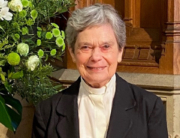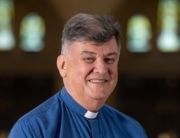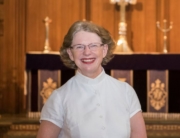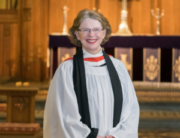Preacher: The Rev’d Canon Jenny Wilson
2 Corinthians 13:11-13, Matthew 28:16-20
In the name of God, creating ,redeeming, sanctifying, … Amen.
Go therefore and make disciples of all nations, Jesus said.
In the last months, we have journeyed, again, with the story of Christ. Through Lent, we have pondered what we are like, what it is to be a human being, physically and spiritually frail, made though in the image of God, forgiven by the great love of God. When we entered Holy Week, we saw what God is like as we watched Jesus die, loving those courageous enough to stand at the foot of his cross, lovingly forgiving those who nailed him there. We gathered at dawn on Easter Day, to wonder again at the mystery of the resurrection, to know the God we gather to worship here as the God and Father of Christ, the God who raised Jesus from the dead. We listened to the resurrection stories until, last week, we heard, from the Gospel of John, the story of Jesus appearing to the frightened disciples in the upper room. “Peace be with you,” Jesus said, showing the disciples his hands and his side. “As the Father sent me so I send you.” Then he breathed on them, and said to them, “Receive the Holy Spirit.” (John 20:19-22) Matthew Anstey, last week on Pentecost Sunday, pointed out that the word “breathed” that is used in the creation account in the book of Genesis is the same word “breathed” used here. The writer of John’s Gospel is making it quite clear that we are looking at God’s new creation in the resurrection and the breathing of the Holy Spirit. This spirit, the spirit of the crucified and risen Jesus, has as its heart, God’s heart, love and forgiveness.
And so today, gathering as we do in the liturgical Year of Matthew, we hear Matthew’s final words – the account of Jesus’ commissioning of his disciples.
Go therefore and make disciples of all nations, baptizing them in the name of the Father and of the Son and of the Holy Spirit, 20and teaching them to obey everything that I have commanded you. And remember, I am with you always, to the end of the age. (Matthew 28:19-20)
“I am with you always” is one of the key themes of the Gospel of Matthew, the one that speaks of the coming of “Emmanuel”, God with us.
As we have made this journey through the story of Christ, we have lived our own story in the midst of the world in a time of great struggle. Two weeks ago, in the wake of the violence in Manchester, I stood here and spoke about Barack Obama’s never wishing to address his country again about issue of violence … and now, less than two weeks later, another burst of hatred erupts in London. We pondered, two weeks ago, the undeniable truth, that our hearts are not as big as God’s heart, and so some acts of violence affect us more than others. That a nurse from our own state died in the violence in London rushing to help others cannot but move us. These events leave us feeling a sense of helplessness, compassion, fear, anger …. The story of God holds all these things – love and hate, peace and violence, birth and death, forgiveness and the great struggle to forgive. The story of the God who we are promised will be with us always.
Next week, and for week after week following on from that, we will enter the season of what are liturgically known as Ordinary Sundays. From next week, and for week after week after that, the colour in our cathedral, and churches across the world, will be green. We will enter the long season of the precious ordinary days, as I sometimes think of them. Before that, though, this Sunday, Trinity Sunday, we pause to wonder about something. We pause to wonder about the nature of God. What is God like? This is a question we engage with, with some trepidation.
What is God like? Baptise “in the name of the Father, Son and Holy Spirit,” Jesus tells his disciples. “The grace of the Lord Jesus Christ, the love of God and the communion of the Holy Spirit be with you all.” Paul writes at the close of his second letter to the people of Corinth, words that we know and say as “the grace”.
Paul could have finished his letter, “God be with you”, and Jesus could have exhorted us to baptise new disciples “in the name of God”, so this threefold blessing, this pointing to God as three “persons”, one God, as the theologians put it, does matter. Is there anything in the idea of Trinity that can help us in our task of gathering others in and living in the great love of God? Is there any image or idea that can help us to pray when innocent people are killed going to concerts, going about their business on bridges and in markets?
When Jesus is asked what God is like, he tells stories, often parables. What is God like? “There was a man with two sons…” Jesus begins the story of the Prodigal Son. “Who is my neighbour?” Jesus is asked. “A man went down a road to Jericho …” and so Jesus tells the story of the Good Samaritan. One theologian, Alister McGrath, explores the idea that the idea of the Trinity is actually a “story”, a story about God. That an abstract definition for God would probably be unhelpful, but that a story tells us much.
“The doctrine of the Trinity can be seen as a summary of the story of God’s dealings with Israel and the church.” McGrath writes. “It affirms that God is active in the world, that God is made known by God’s actions, and points to that creation, the death and resurrection of Jesus Christ, and Pentecost, as turning points in God’s dealings with us.”[1]
What matters a great deal is that God wants to be known. God reveals who God is. Jesus is sometimes described as God’s self-communication – the “Word”, or message if you like, from God – Jesus is sometimes called a sacrament or window into God. God is not a distant creator; God longs that we know who God is. And so the story of God, the story that is the Trinity – is told. The Father is revealed through the Son. But we might ask how we recognise this revelation. As McGrath puts it, “there must be some means by which Jesus is recognised as the self revelation of God. …The recognition of revelation as revelation must itself be the work of God …[this is] the work of the Spirit.”[2]
When we hear the story of Jesus’ passion, when we hear Jesus saying “I will be with you always”, when we hear these gospel stories and something tells us this is about God, that something is the Holy Spirit. When we see the sun setting as we walk along the beach, or we watch an ibis foraging in the parklands, or we are touched the kindness of another human being … and these things seem to show us something of God, what moves our understanding in this a way is the Holy Spirit. When a young nurse dies running to help a fellow human being on a bridge in London, it is the Holy Spirit that helps us ponder the possibility that we have been shown a glimpse of God.
How, though, do the Father, the Son and the Holy Spirit work together? The scholars warn us that these three “persons” are not three separate beings who do three separate things. What understanding or image will help us here?
Another scholar, Jurgen Moltmann, describes the Trinity as a deeply loving community. “Each person of the Trinity, by virtue of their eternal mutual love, lives in the other two as a fellowship through “a process of perfect and intense empathy”.[3] This is perhaps difficult to connect with the biblical stories but it is worth spending time with. The language of John’s Gospel, where Jesus invites us to abide in God, does resonate. “You will know that I am in the Father, and you in me and I in you.” Jesus says, “…the Holy Spirit, whom the Father will send in my name, will teach you everything …” he continues. (John 14:20,26) If the essence of the nature of God is loving community, human beings, and especially the church, are encouraged to live in loving community.
The idea of the Trinity as a loving community is illustrated by a well-known icon. On the front of our orders of service this morning is an image of Rublev’s Trinity, an icon created in the 15th century by Russian painter Andrei Rublev. The icon depicts the three angels visiting Abraham at the Oak of Mamre from Genesis 18, but it is interpreted as an image of the Trinity. What is fascinating about the three figures is the direction in which they are facing …the loving gaze from one to another, the community gathered around the table. If we gaze at the icon for a long time we may find that we feel invited into this community of love. We might well imagine prayer as being gathered in to sit at this table. This place of love, this heart of God, is the place where we might safely bring the love and hate, peace and violence, birth and death, forgiveness and the great struggle to forgive that seem to characterise our lives.
Go therefore, Jesus said, and make disciples of all nations, …And remember, I am with you always, to the end of the age. (Matthew 28:19-20) It may be that Alister McGrath’s idea of the Trinity as a story helps us. It may be that we resonate with Jurgen Moltmann’s image of the Trinity as a deeply loving community. It may be that gazing at Rublev’s icon is, for us, a meaningful place to be. However the reality of the nature of God as Trinity touches us, praying and resting in the community of love that is the heart of God will bless us, and will prepare us to take that love to the world.
*
[1] Alister McGrath Theology – The Basics p127.
[2] Alister McGrath p135.
[3] Alister McGrath p132.




